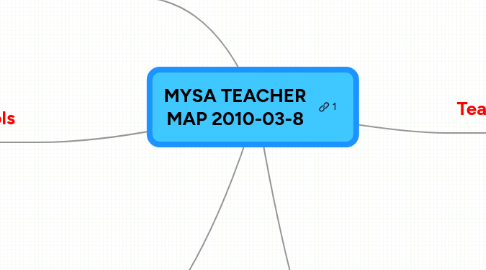
1. Student Welfare and Classroom Management
1.1. Theories
1.1.1. Adolescence
1.1.1.1. Neuroscience
1.1.1.1.1. Video Resource: Inside the Teenage Brain
1.1.1.2. Social Trends
1.1.1.2.1. Generation Z
1.1.2. Positive Psychology
1.1.2.1. Martin Seligman - TED Video
1.1.2.2. University of Pennsylvania
1.1.2.3. The Handbook of Positive Psychoiogy
1.2. Methods
1.2.1. Mentoring
1.2.2. Self-evaluation of Behaviour
1.2.3. Challenge-based Development
1.2.3.1. Camp Programs
1.2.3.2. Excursion Programs
1.2.4. Restorative Justice
1.2.4.1. Kids Skills
1.2.4.1.1. Sorry Letter
1.2.5. Goal Setting and Evaluation
1.2.5.1. Student Led Conferences
1.2.5.1.1. YouTube Video
1.2.5.2. Resilience Audit
1.2.5.2.1. Activity Sheets
1.2.6. Bullying
1.2.6.1. Cyberbullying
1.2.6.1.1. Web Warriors
1.2.7. Classroom Management
1.2.7.1. Positive Routines
1.2.7.1.1. Class Attention
1.2.7.1.2. Homework
1.2.7.1.3. Assignment Planning
1.2.7.2. Monitoring and Evaluation
1.2.7.2.1. Rate The Lesson
1.2.7.3. Storage and Organisation
1.2.8. Mind Matters
2. Personal Career Tools
2.1. Planning, Record Keeping and Time Management
2.1.1. Online Tools
2.1.1.1. Google Calendar
2.1.1.2. To Do Lists
2.1.2. Teacher Diaries
2.1.2.1. Innovative Teachers Companion
2.2. Teacher Resilience
2.3. Job Hunting
2.3.1. Seek.com.au
2.3.2. Government
2.3.2.1. Queensland
2.3.2.2. Victoria
2.3.2.3. New South Wales
2.3.2.4. South Australia
2.3.2.5. Tasmania
2.3.2.6. Northern Territory
2.3.2.7. Australian Capital Territory
2.3.2.8. Western Australia
2.3.2.9. New Zealand
2.4. Postgraduate Studies
2.4.1. Masters Degrees
2.4.1.1. University of Queensland
2.4.1.2. Griffith University
3. Colleagues, Peers and the Broader Community
3.1. Colleagues
3.1.1. Sharing Resources
3.1.1.1. File Storage and Sharing
3.1.1.1.1. 4shared
3.1.1.1.2. Google Docs
3.1.2. Team Planning
3.2. Parents
3.2.1. Complaint Management
3.3. Outside Help and Services
4. Content-Specific Ideas
4.1. Science
4.1.1. Scientific Report Templates
4.2. Maths
4.3. English
4.3.1. Persuasive Pieces
4.3.2. Newspaper Articles
4.3.3. Poetry
4.3.4. Narratives
4.4. History
4.5. Health
4.6. Technology
4.7. The Arts
4.8. Technology
4.9. Religion
4.10. Literacy
4.10.1. Vocabulary Building
4.10.2. Paragraph Construction
4.10.3. Reading Strategies
4.10.3.1. Top Level Structures
4.10.3.1.1. Templates
4.10.4. Genres
5. Teaching Methods
5.1. Inquiry-based Learning
5.1.1. Planning For Inquiry Based Learning
5.1.2. Unit Templates
5.1.3. YouTube Demo
5.2. Collaborative Learning
5.2.1. Group Roles
5.2.2. Peer Tutoring
5.2.3. Cooperative Strategies
5.2.4. Group Planning
5.3. Thinking Techniques
5.3.1. Problem Solving
5.3.1.1. Open Problems
5.3.1.2. Closed Problems
5.3.2. Systems Thinking
5.3.2.1. WebEd
5.3.2.2. Creative Learning Exchange
5.3.2.3. Isee Systems
5.3.3. Graphic Organisers
5.3.3.1. Exploratree
5.3.4. Structuring Arguments
5.3.5. Philosophical Discussion
5.3.6. Teacher Questioning
5.3.7. Map of Online Collaboration Tools
5.4. Project-based Learning
5.4.1. Unit Templates
5.4.2. Planning Using Set Content
5.4.2.1. Exploratree Template
5.5. Assessment
5.5.1. Self and Peer Evaluation
5.5.2. Rubrics/Criteria Sheets
5.5.2.1. Rubric Creating Tool
5.5.2.2. Detailed Guide For Writing Criteria Sheets
5.5.3. Folios
5.6. Research Skills and Information Literacy
5.6.1. Search Methods
5.6.2. Useful Databases
5.6.2.1. Gapminder
5.6.2.1.1. YouTube Demo
5.6.3. Referencing
5.6.4. Webquests
5.6.4.1. Templates
5.7. Providing Student Voice
5.7.1. Negotiating Within Set Topics
5.7.1.1. Unit Templates
5.7.2. Beane and Brodhagen Model
5.7.2.1. Negotiation Mandala
5.7.2.2. Unit Templates
5.7.3. Multimedia and Student Voice
5.7.3.1. YouTube
5.7.4. Student Empowerment

